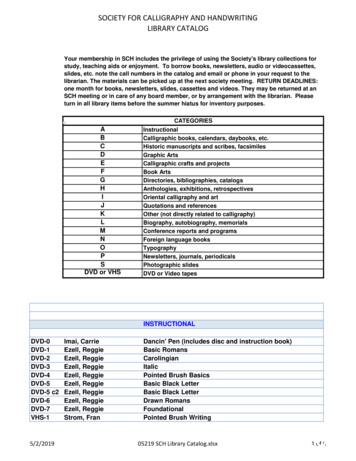Chemical Calligraphy V1
Chemical Calligraphy v1.1Now With Bonds and Hydrogens!Chemical Calligraphy is a way of drawing organic compounds, this method is NOT meant to replacestandard notation, it is primarily meant as a mnemonic device and art form.Chemical Calligraphy attempts to simplify the memorization of the large complex molecules andstructures in organic chemistry and make the learning process more fun and engaging.For large complex molecules 2D, even standard notation, is not accurate. Visualization is best donewith computers and 3D rendering. Here we focus on the elements and their arrangement notstereo-chemistry.Chemical Calligraphy v1.0 is the base framework. It drops hydrogens, bond strength, andstereo-chemistry. In v1.1 hydrogens and bond strength are added back in. They are both representedwith dots, and can be considered a “second layer” of chemical calligraphy.For full details on v1.0 see http://dscript.org/chem.pdfBond strength and hydrogens are denoted by dots and dashesBond strength is “default 1”, adding dots in the line of the bond will increase the bond strength.Hydrogens are dots(or dashes/single lines) floating around the structure.On the following pages are the amino acids, drawn in various forms of Chemical Calligraphy.While there is more than one way todraw the amino acid group, I will stickwith this form. (on the right)I like how it helps visually grouptogether the unit.The Amino acids are shown in standard notation and in some basic forms first.They are also shown in some playful artistic forms. In these forms the information about atoms andwhich other atoms they bond with is all still present, even bond strength and hydrogens(when included)The artistic forms distort the overall shape (not that 2D notation is accurate to begin with)The simpler more “rigid” form of 90 degree angles and straight lines is best for mnemonic purposes.The function of the artistic forms isa)Art Form – An art form that encodes chemical structures (“bring science into art or vice-versa”)b)Engagement – Even though creating such “ridiculous” structures might not have any direct relationto the molecules, the simple act of choosing a structure and “playing with it” helps make study morefun, which, I find, makes study more enjoyable and efficient (because I am more creatively engaged)
One important note to keep in mind is that when you start curving the lines of carbon chains, it ispossible that they might, under the right conditions, become ambiguous with a sulfur.This is easily just “avoided”, just review the structure and check multiple carbon chains to see if it ispossible to “see an sulfur instead of 2 carbons”, if so, avoid that method.There are various ways of resolving this, but I have not yet decided on a “rule”. I am leaning towards“allow maximum flexibility for carbon, and restrict sulfur. Or just use sulfur in encapsulated form”.Chemical calligraphy is an extension on the Dscript 2D alphabetical writing system,More info on Dscript Alphabetical : http://dscript.org/dscript.pdfYou may also like.Cscript – Computer Human Bi-Friendly Writing Systemhttp://dscript.ca/cscript.pdfthink of Cscript as “somewhere between QR codes and handwriting”Nscript – Hammer & Nail Based Layered Writing Systemhttp://dscript.org/nailscript.pdfWscript – Wire Based 2D/3D Writing Systemhttp://dscript.org/wirescript.pdfChemical Calligraphy 1.0 : http://dscript.org/chem.pdf“Mad Science”/”Technology Art” inventions and experiments. Great DIY fun.http://dscript.org/inventions.pdfDscript by Matthew DeBlock is licensed under a Creative Commons AttributionBased on a work at www.dscript.ca and www.dscript.org3.0 Unported License.
Chemical Calligraphy v1.1 Now With Bonds and Hydrogens! Chemical Calligraphy is a way of drawing organic compounds, this method is NOT meant to replace standard notation, it is primarily meant as a mnemonic device and art form. Chemical Calligraphy attempts to simplify the memorization of the large complex molecules and
Art History 101 Calligraphy lesson plan By Rudy Navarro Learning objectives 1. Recall that calligraphy is one of the three design elements in Islamic art 2. Distinguish between Kufic and cursive styles of calligraphy 3. Recall the principles of calligraphic aesthetics a. Calligraphy is the most important of the three design elements in Islamic .
A59 c.2 Harris, David Calligraphy: Modern Masters A59 c.3 Harris, David Calligraphy: Modern Masters A60 Child, Heather, ed. The Calligrapher's Handbook A61 Nash, John Practical Calligraphy A62 Guyot, Don Suminagashi: An Introduction to Japanese Marbling A63 Halliday, Peter, ed. Calligraphy Masterclass A64 Ka
Calligraphy Learn how to write beautifully and develop your creativity with calligraphy. You will learn fundamental approaches, letterforms, layout and design. Calligraphy can be used to enhance artwork, illustrate writing, create invitations or as a stand-alone art form. Calligraphy - beginners and progression to intermediate
discuss art, crafts, and calligraphy will be encouraged. Although Student Teachers are encouraged to pursue their own interests in art, crafts, and calligraphy, the intent of the course is to prepare for teaching, and so the teach-ing-learning approaches used should model the approach to art, crafts, and calligraphy in an elementary classroom.
Calligraphy has developed as a handwriting art across the globe throughout history. Egyptian heiroglyphics, manuscripts from the Middle Ages and many East Asian writing systems are all examples of calligraphy. Calligraphy is similar to hand lettering but usually describes cursive script where
written calligraphy as a necessity for political advancement. A set of running script (lot 8000) by the top four finishers of the final exam in 1904 attests to these durable links between calligraphy and status. Whereas the seal on Ronghui Huang Guifei’s calligraphy (lot 8002) illuminates the fact that despite the fall of the Qing, members of the
DRAWING & CALLIGRAPHY INK Speedball’s rich, vivid calligraphy inks are formulated from the best pigments on earth. These high-quality inks are ideal for a variety of techniques including calligraphy, drawing, stamping, airbrushing, and scrapbooking. Inks are inter-mixable, waterproof, lightfast, acid-free and archival, providing artists and
Astrophysics Research Institute The Astrophysics Research Institute (ARI) is one of the world’s leading authorities in astronomy and astrophysics. Its work encompasses a comprehensive programme of observational and theoretical research, telescope operation, instrument development, academic learning and outreach activities. The ARI has been honoured with various awards and prizes including: n .























